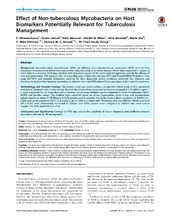| dc.contributor.author | Dhanasakeran, S. | en_US |
| dc.contributor.author | Jenum, Synne | en_US |
| dc.contributor.author | Stavrum, Ruth | en_US |
| dc.contributor.author | Wiker, Harald G. | en_US |
| dc.contributor.author | Kenneth, John | en_US |
| dc.contributor.author | Vaz, Mario | en_US |
| dc.contributor.author | Doherty, Tanya Mark | en_US |
| dc.contributor.author | Grewal, Harleen | en_US |
| dc.date.accessioned | 2014-12-30T08:50:59Z | |
| dc.date.available | 2014-12-30T08:50:59Z | |
| dc.date.issued | 2014-10-16 | eng |
| dc.identifier.issn | 1935-2727 | |
| dc.identifier.uri | https://hdl.handle.net/1956/9052 | |
| dc.description.abstract | Background Non-tuberculous mycobacteria (NTM) are different from Mycobacterium tuberculosis (MTB) both in their ubiquitous environmental distribution and in their reduced capacity to cause disease. While often neglected in favour of other infectious diseases, NTM may interfere with important aspects of TB control and management, namely the efficacy of new anti-tuberculosis (TB) vaccines; the immuno-diagnostic Tuberculin skin test (TST) and QuantiFERON TB Gold In Tube assay (QFTGIT); and immune biomarkers explored for their diagnostic and/or predictive potential. Our objective was therefore to explore host immune biomarkers in children who had NTM isolated from respiratory and/or gastric specimens. Methodology and Principle Findings The present study was nested within a prospective cohort study of BCG-vaccinated neonates in Southern India. In this setting, immune biomarkers from peripheral blood were analyzed in 210 children aged <3 years evaluated for TB using dual-colour-Reverse-Transcriptase-Multiple-Ligation-dependent-Probe-Amplification(dcRT-MLPA) and Bio-Plex assays. The children were classified based on clinical examination, chest X-rays and mycobacterial culture reports as either: 1) TB disease, 2) NTM present and 3) controls. The study shows a down-regulation of RAB33A (p<0.001) and up-regulation of TGFβ1, IL-2 and IL-6 (all p<0.05) in children with TB disease, and that RAB33A, TGFBR2 and IL-10 (all p<0.05) were differentially expressed in children with NTM present when compared to children that were culture negative for MTB and NTM (controls). Conclusions and Significance Carriage of NTM may reduce the specificity of future diagnostic and predictive immune biomarkers relevant to TB management. | en_US |
| dc.language.iso | eng | eng |
| dc.publisher | PLoS | eng |
| dc.rights | Attribution CC BY | eng |
| dc.rights.uri | http://creativecommons.org/licenses/by/4.0 | eng |
| dc.title | Effect of Non-tuberculous Mycobacteria on Host Biomarkers Potentially Relevant for Tuberculosis Management. | en_US |
| dc.type | Peer reviewed | |
| dc.type | Journal article | |
| dc.date.updated | 2014-12-30T08:46:01Z | |
| dc.description.version | publishedVersion | en_US |
| dc.rights.holder | Copyright 2014 Dhanasekaran et al | |
| dc.source.articlenumber | e3243 | |
| dc.identifier.doi | https://doi.org/10.1371/journal.pntd.0003243 | |
| dc.identifier.cristin | 1168603 | |
| dc.source.journal | PLoS Neglected Tropical Diseases | |
| dc.source.40 | 8 | |
| dc.source.14 | 10 | |

